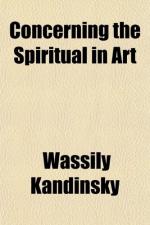The true inner forces do not lose their strength and effect so easily. [Footnote: A comparison between the work of Poe and Maeterlinck shows the course of artistic transition from the material to the abstract.] An the word which has two meanings, the first direct, the second indirect, is the pure material of poetry and of literature, the material which these arts alone can manipulate and through which they speak to the spirit.
Something similar may be noticed in the music of Wagner. His famous leitmotiv is an attempt to give personality to his characters by something beyond theatrical expedients and light effect. His method of using a definite motiv is a purely musical method. It creates a spiritual atmosphere by means of a musical phrase which precedes the hero, which he seems to radiate forth from any distance. [Footnote: Frequent attempts have shown that such a spiritual atmosphere can belong not only to heroes but to any human being. Sensitives cannot, for example, remain in a room in which a person has been who is spiritually antagonistic to them, even though they know nothing of his existence.] The most modern musicians like Debussy create a spiritual impression, often taken from nature, but embodied in purely musical form. For this reason Debussy is often classed with the Impressionist painters on the ground that he resembles these painters in using natural phenomena for the purposes of his art. Whatever truth there may be in this comparison merely accentuates the fact that the various arts of today learn from each other and often resemble each other. But it would be rash to say that this definition is an exhaustive statement of Debussy’s significance. Despite his similarity with the Impressionists this musician is deeply concerned with spiritual harmony, for in his works one hears the suffering and tortured nerves of the present time. And further Debussy never uses the wholly material note so characteristic of programme music, but trusts mainly in the creation of a more abstract impression. Debussy has been greatly influenced by Russian music, notably by Mussorgsky.




